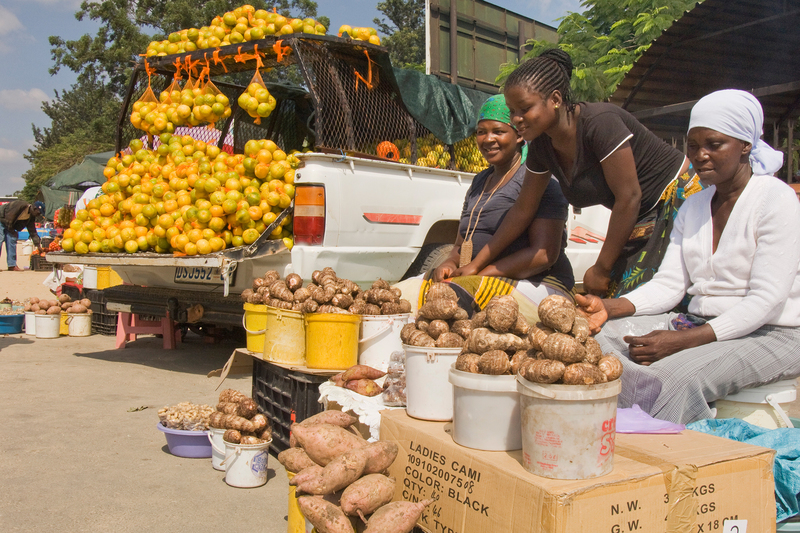Economic implications of COVID-19 in Africa
07 May 2020 | Story Ambre Nicolson. Photo Media Club, Flickr. Read time 9 min.
Recent research from health economist John Ataguba, an associate professor in the Health Economics Unit at the University of Cape Town (UCT), calls for African governments to take drastic steps to avoid economic crisis.
In his paper, published in Applied Health Economics and Health Policy, Ataguba likens the COVID-19 pandemic to a war that must be won.
“I used this martial metaphor because COVID-19 is an enemy with an intent to kill. This is what wars are about,” he explains. “It is essential for the mindset that is needed to address it. When it is viewed as a war to be won, there will be significant efforts to addressing it and the galvanisation of resources towards ending it.
“It is not a war that we are prepared to lose.”
Ataguba argues that, until recently, analyses of the economic implications of the COVID-19 pandemic focused mainly on global and macroeconomic impacts.
“In Africa, however, with its high disease burden, poorly developed infrastructure and large informal economies, the macroeconomic outlook is just part of a bigger picture. Ultimately, the impact on individuals is vital, as they form, to a large extent, the basis for the total impact on a country.
“The productivity a country enjoys comes from the health and productivity of its inhabitants.”
Looking at both the micro- and macroeconomic costs associated with the COVID-19 pandemic in Africa, what does Ataguba believe to be the most likely economic implications of the COVID-19 pandemic in African economies?
Microeconomic impacts: more out-of-pocket health spending
“At the microeconomic level, the pandemic is likely to affect African households in a number of ways, including driving up out-of-pocket health spending and leading to drastic income losses for informal workers,” he says.
“The productivity a country enjoys comes from the health and productivity of its inhabitants.”
“Families may bear costs for diagnosis and treatment where, for example, they are not covered by the government or health insurance schemes. Even where these costs are covered, households may still incur co-payments, transport costs and other related expenses, including the indirect costs of care.”
Ataguba also points out that in sub-Saharan Africa, informal workers, mostly women, make up 89% of all those employed.
“For many households holding informal employment or informal work, they do not have any social or income protection: if they do not work for a day, they lose a day’s income. The longer they stay out of work, the longer the loss.
“Depending on what happens post-lockdown, some informal employment may no longer exist and such workers may have to shift to other productive activities. This is a case of structural unemployment.”
To further illustrate, Ataguba points out that while South Africa does not have a large informal economy compared to the rest of Africa, it still accounts for one-third of all the country’s workers. They are responsible for 10% of the country’s gross domestic product (GDP).
This 10% share of the GDP is higher than the total health expenditure of the country, which is about 8.5% of the GDP. In other African countries, with larger informal sectors, the impact will be greater.
… while South Africa does not have a large informal economy compared to the rest of Africa, it still accounts for one-third of all the country’s workers.
Macroeconomic impacts: declining productivity, rising inflation
Ataguba believes the COVID-19 pandemic could increase inflation due to commodity scarcity.
“Macroeconomic impact is understood by looking at economic aggregates, such as a country’s GDP, unemployment and inflation rates. If there is a large decline in productivity – or a reduction in imports from countries affected by the COVID-19 pandemic – this could fuel a rise in prices.”
Ataguba also explains that if exporters are unable to export goods, it may lead to a loss of productivity and jobs.
“In Nigeria, for instance, the falling global price of oil in the face of the COVID-19 pandemic has forced the country to devalue its currency, the Naira.”
In addition to sharply downgraded economic growth forecasts and enormous volatility in stock markets, Ataguba points out that the imminent threat of the pandemic may lead to a problem of ‘crowding out’. This means spending on COVID-19 activities takes away money that could be used for other public health activities.
“But, just like in times of war, when a country’s spending on defence increases significantly, countries in Africa must view the COVID-19 pandemic as a ‘war’ to be won and be prepared to increase public health spending significantly.”
A message to governments
What advice would Ataguba give to the leaders of African states?
“The simple answer is that countries must invest in effectively communicating and engendering trust and confidence. Panic and uncertainty have wreaked more havoc than confirmed cases or deaths – as it stands. But in reality, there is no one-size-fits-all answer to this question.
“Panic and uncertainty have wreaked more havoc than confirmed cases or deaths – as it stands.”
“For those countries with fewer cases, this is the time to invest in prevention strategies and engender trust in states’ authority. Those with a large number of confirmed cases, in addition to using preventive measures, must be prepared to spend public funds to trace, test and manage COVID-19 infections,” Ataguba continues.
“In addition to deaths and significant morbidities from the COVID-19 pandemic, there will be a substantial cost to the economy, which requires drastic steps and actions, backed by a strong will and desire from the government and its people.”
- Ataguba J (2020) COVID-19 pandemic, a war to be won: understanding its economic implications for Africa. Applied Health Economics and Health Policy. https://doi.org/10.1007/s40258-020-00580-x
 This work is licensed under a Creative Commons Attribution-NoDerivatives 4.0 International License.
This work is licensed under a Creative Commons Attribution-NoDerivatives 4.0 International License.
Please view the republishing articles page for more information.
Research & innovation





































